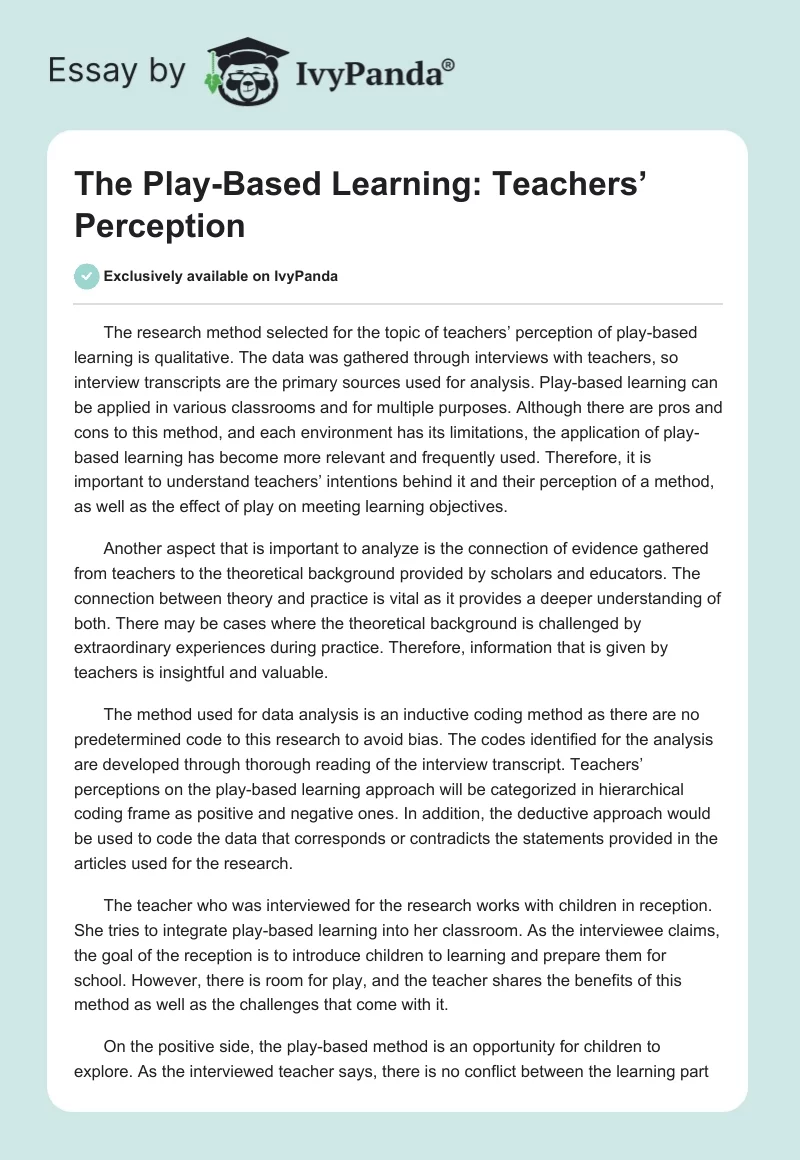The research method selected for the topic of teachers’ perception of play-based learning is qualitative. The data was gathered through interviews with teachers, so interview transcripts are the primary sources used for analysis. Play-based learning can be applied in various classrooms and for multiple purposes. Although there are pros and cons to this method, and each environment has its limitations, the application of play-based learning has become more relevant and frequently used. Therefore, it is important to understand teachers’ intentions behind it and their perception of a method, as well as the effect of play on meeting learning objectives.
Another aspect that is important to analyze is the connection of evidence gathered from teachers to the theoretical background provided by scholars and educators. The connection between theory and practice is vital as it provides a deeper understanding of both. There may be cases where the theoretical background is challenged by extraordinary experiences during practice. Therefore, information that is given by teachers is insightful and valuable.
The method used for data analysis is an inductive coding method as there are no predetermined code to this research to avoid bias. The codes identified for the analysis are developed through thorough reading of the interview transcript. Teachers’ perceptions on the play-based learning approach will be categorized in hierarchical coding frame as positive and negative ones. In addition, the deductive approach would be used to code the data that corresponds or contradicts the statements provided in the articles used for the research.
The teacher who was interviewed for the research works with children in reception. She tries to integrate play-based learning into her classroom. As the interviewee claims, the goal of the reception is to introduce children to learning and prepare them for school. However, there is room for play, and the teacher shares the benefits of this method as well as the challenges that come with it.
On the positive side, the play-based method is an opportunity for children to explore. As the interviewed teacher says, there is no conflict between the learning part of the class and play. For her, the play-based method creates an opportunity to cover more topics than she expects when the process of learning is teacher-based. The most effective strategy is “…if you’re taking their lead, you don’t know where it’s going to go, and you can usually cover so many areas…”. Therefore, the lack of limitations is one of the most significant strengths of a play-based method.
In the interview, the teacher used phrases such as “It is the best way to learn” and “It is limitless” to describe the approach in general. In addition, the themes such as “learn how to negotiate with their friends” and “learn how to be independent in their learning” refer to the benefits of play-based learning. Therefore, the interview identified numerous positive aspects of the approach.
However, when asked about the weaknesses of the method, the interviewee named only one: “I suppose the only weakness is because of the expectations.”. By saying that, the teacher refers to the fact that the government imposes the curriculum and learning objectives of the reception. This creates expectations that after a year, children are expected to be able to construct a sentence, for example. However, that does not take into account the fact that children enter the reception with different knowledge backgrounds, and while some of them are already capable of writing letters, others do not recognize certain sounds. The need to meet those expectations regardless of children’s entry-level and pace is a challenge to the implementation of the play-based method.
The interview provides an insight and evidence to the statement made by Edwards (2017) in his “Play-based learning and intentional teaching: Forever different?” article about the fact that play and learning are different processes. Indeed, the teacher said that there are challenges in meeting governmental learning objective in the end of the year. Therefore, she aims at finding balance between teacher-led and children-led activities, which corresponds with Edwards’s findings. Secondly, the interview corresponds with the ideas expressed by Ali, Constantino, Hussain, and Akhtar (2018) about the positive impact of play-based approach on children’s communicative and creative skills. Researches by Bubikova-Moan, Næss Hjetland (2019), and Wollscheid and Taylor and Boyer (2020) identified positive impact of play-based learning on the emotional intelligence of children. However, the interview did not provide direct evidence on this specific point.
The research is much beneficial to teachers who want to learn more about the play-based approach. The insights gathered from the experience of other educators enhance their understanding of practical aspects, while the connection to theoretical background enhances the justification of the approach. In order to communicate the findings of the research, it should be published and made available for reading in some of the largest and most accessible academic databases, such as ProQuest and Google Scholar. Besides, mentioning the research in academic or popular science journals would increase the number of people who could read the interviews and familiarize themselves with the research’s findings.
Reference List
Ali, E., Constantino, K.M., Hussain, A. and Akhtar, Z., 2018. The effects of play-based learning on early childhood education and development. Journal of Evolution of Medical and Dental Sciences, 7(43), pp.6808-6811.
Bubikova-Moan, J., Næss Hjetland, H. and Wollscheid, S., 2019. ECE Teachers’ views on play-based learning: a systematic review. European Early Childhood Education Research Journal, 27(6), pp.776-800.
Edwards, S., 2017. Play-based learning and intentional teaching: Forever different?. Australasian Journal of Early Childhood, 42(2), pp.4-11.
Taylor, M.E. and Boyer, W., 2020. Play-based learning: evidence-based research to improve children’s learning experiences in the kindergarten classroom. Early Childhood Education Journal, 48(2), pp.127-133.


